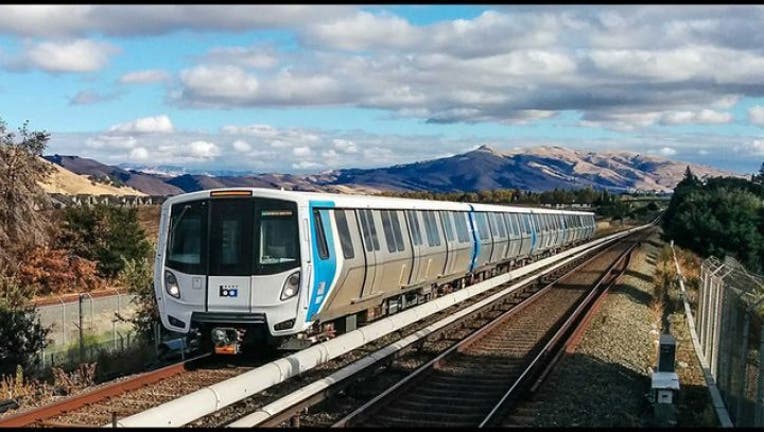VTA BART expansion work to include minority-owned business

Courtesy: BART
San Jose, Calif. - VTA has pledged to increase contracting opportunities for minority-owned businesses in its ongoing BART expansion into San Jose.
Sergio Lopez, mayor of Campbell and chair of VTA's board of directors, signed the Equity in Infrastructure Project pledge on behalf of the agency Monday, alongside more than a dozen local government agencies. The VTA board unanimously approved the pledge last week. Lopez said the public transit agency is working with 72 disadvantaged business enterprises and 25 small businesses on the BART expansion to date. He said there will be more opportunities to engage local minority-owned businesses as the project progresses.
"Diversity is what drives our economic success in Silicon Valley," Lopez told San Jose Spotlight. "I'm really proud that VTA can be a leader in this area and the board's fully committed to supporting that work."
In 2021, VTA pledged to diversify its contractors for the BART expansion but decreased its goal from 20% of the project's money going toward minority-owned businesses to 15% after reassessing certain parts of the project. That included the project's single-bore drill, which few companies produce or operate nationwide.
NAACP San Jose/Silicon Valley President Sean Allen said he isn't sure how genuine the pledge will be, given VTA has had the opportunity to engage minority-owned businesses without the pledge. He said this problem isn't just with VTA, pointing at a study released last April showing local minority-owned businesses only make up about 15% of Santa Clara County's contract payouts.
"Clearly there's a lot of roadblocks in the system that are not only preventing but are also discouraging minority-owned business growth in our community, and so I have some serious suspicions about the bidding process being biased," Allen told San Jose Spotlight.
The project to connect Silicon Valley to the BART system has been decades in the making, and its budget has ballooned to $12.8 billion as of last year. The Federal Transportation Administration awarded VTA a $5.1 billion grant last August, but the grant only covers part of VTA's request, leaving a $700 million shortfall in the project's budget.
VTA directors have been discussing how to bridge the gap and are exploring multiple options that, combined, could reach the total. That would include changing some station design aspects, such as service parking lots, as well as larger features like how the tunnels are bored and debris is removed.
A VTA spokesperson said cost and schedule savings for the potential changes are being evaluated and will be presented to the board and project's oversight committee in the spring. The station design changes could total to about $145 million in savings, though estimates are still being calculated for other potential cost-saving mechanisms.

BART riders might be able to commute for less
A board will vote on taking part in a pilot program that would cut the cost of transfers between BART and 20 other agencies. You would pay full price for the first leg of your trip and the second and third legs would be discounted.
Lopez said the most promising solution so far is boring the tunnel from both ends. Initial plans will launch a single-bore drill from the Newhall Maintenance Facility in Santa Clara, to dig from west to east. VTA officials raised the possibility of launching a second drill from the Berryessa Station in East San Jose and digging from east to west. Both drills would meet in the middle, saving time and money.
"That saves a lot of time, that's going to be one of the most impactful options that we can have," he told San Jose Spotlight. "Things that can keep the project moving along or even speed it up ... seem like a no-brainer."
Suds Jain, a Santa Clara councilmember and VTA board member, said he wants to see a more efficient plan to remove debris from the tunnel. VTA plans to use trucks to drive the debris or "muck" out of Santa Clara toward the Central Valley, but officials are now considering using trains to haul it out or bring it to a dumping location closer to Silicon Valley, such as local quarries.
Jain voiced concerns about using two drills and said he hasn't gotten any sort of estimated cost for the second drill or the needed safety measures, but that it does so far sound like the biggest potential cost-saving mechanism.
On top of bridging the funding gap, Jain also said he's concerned about VTA's grant, which needs final federal approval by August to receive the money. It's unclear how the incoming Trump administration may react to the grant.
These cost-saving mechanisms will have to be decided in time for the August approval.
"Our staff continues to be in close contact with federal staff to make sure that they understand where we are with the project and the parameters on where we're moving to," Lopez said.
Featured
BART considering name change for Oakland's Lake Merritt station
Lake Merritt's BART Station may not be called that for much longer, as a proposal has been made to change the name to "Oakland Chinatown."


